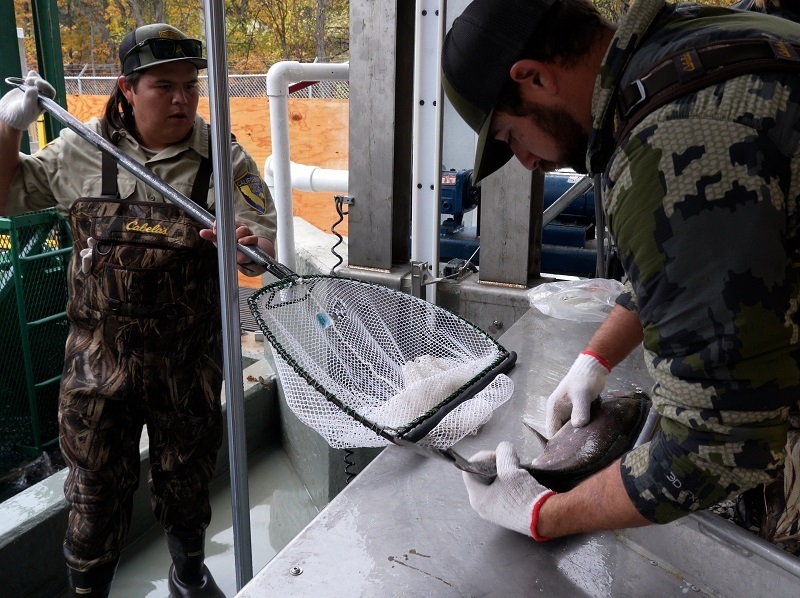Klamath River - Upper - CA Fish Report for 11-23-2024
Threatened Coho Salmon Return to Upper Klamath River Basin for First Time in More Than 60 Years
Klamath River - Upper - CA - Hornbrook, CA (Siskiyou County)

by California Department of Fish & Wildlife
11-23-2024
Website
CDFW releases 270,000 fall-run Chinook salmon into Fall Creek, the first yearling hatchery salmon release following historic dam removal
Media Note: Download photos, video and interviews involving CDFW’s salmon work in the Klamath Basin here.
The California Department of Fish and Wildlife (CDFW) has seen the first returns of threatened coho salmon to the upper Klamath River Basin in more than 60 years following historic dam removal completed last month. Not since the construction of the former Iron Gate Dam in the early 1960s has CDFW documented coho salmon occupying their historic habitat in the upper watershed.
On Nov. 13, seven coho salmon entered CDFW’s new Fall Creek Fish Hatchery in Siskiyou County, which is located on Fall Creek, a formerly inaccessible Klamath River tributary about 7.5 miles upstream of the former Iron Gate Dam location.
“To see coho successfully returning this quickly to this new habitat post-dam removal is exciting,” said Eric Jones, a Senior Environmental Scientist who oversees CDFW’s north state hatchery operations. “We’ve already seen the Chinook make it back and now we’re seeing the coho make it back.”
Of the seven coho salmon that entered the Fall Creek Fish Hatchery last week, four were male and three were female. Two had missing adipose fins, identifying them as being of hatchery origin. The other five were natural origin fish as all hatchery raised coho salmon in the Klamath Basin have their adipose fins removed for identification prior to release.
The returning coho are being kept at the Fall Creek Hatchery pending genetic testing at the NOAA Southwest Fisheries Science Center laboratory in Santa Cruz. Geneticists will determine which of the seven coho are the least related genetically and direct the spawning of those pairs to maximize genetic diversity.
Coho salmon in the Klamath Basin are listed as a threatened species under both state and federal endangered species acts. Coho salmon typically return to freshwater to spawn in the late fall and winter, later than the more numerous fall-run Chinook salmon.
CDFW’s Fall Creek Fish Hatchery has an annual production goal of raising 75,000 coho salmon to help restore populations in the upper Klamath River Basin post dam-removal.
Also pertaining to CDFW’s salmon work in the Klamath Basin:
** CDFW last week released approximately 270,000 yearling, fall-run Chinook salmon into Fall Creek, the last Klamath Basin hatchery release of the year and the first release following dam removal. The year-old juvenile salmon, approximately 4 to 6 inches in length, were released over four days, mostly at dusk to improve survival, and allowed to swim freely out of the hatchery into Fall Creek without handling.
“We’re releasing various life histories so that gives the fish a chance to out-migrate at different times of the year mimicking what we would see in the river naturally,” said Crystal Robinson, Senior Environmental Scientist and CDFW’s Klamath Watershed Program Supervisor.
Hatchery salmon released as yearlings in the fall show some of the highest rates of return as adults, which is attributed to their larger size at release and optimal fall river conditions with cool temperatures and strong flows.
** CDFW’s Fall Creek Fish Hatchery, a $35 million, state-of-the-art facility in its first year of operation, began spawning returning fall-run Chinook salmon in late October. To date, the hatchery has spawned 100 fish and collected 277,393 eggs. The hatchery has an ambitious annual production goal of 3.25 million fall-run Chinook salmon.
** Multiple state and federal agencies, Tribes and non-governmental organizations are monitoring salmon throughout the Klamath Basin, including the 420 miles of newly accessible habitat following dam removal. CDFW is particularly focused on newly accessible tributaries within the former reservoir footprints, including Jenny and Shovel creeks. To date, a video fish counting weir installed on Jenny Creek has recorded 310 adult Chinook salmon and one Pacific lamprey entering the tributary from the Klamath River. CDFW field crews are surveying regularly for salmon nests, or redds, and post-spawned adults.
The salmon work taking place in the Klamath Basin reflects all six priorities of Gov. Gavin Newsom’s California Salmon Strategy for a Hotter, Drier Futurereleased in January 2024. Those priorities are removing barriers and modernizing infrastructure for salmon migration; restoring and expanding habitat for spawning and rearing; protecting water flows and water quality at the right times to benefit salmon; modernizing salmon hatcheries; transforming technology and management systems for climate adaptability; and strengthening partnerships.
CDFW’s post-dam removal management strategy, as detailed in the recently released Klamath River Anadromous Fishery Reintroduction and Monitoring Plan, is to mostly allow these ocean-going fish species to naturally repopulate the 420 miles of newly accessible habitat as they are now doing.
< Previous Report Next Report >
< Previous Report Next Report >
More Reports

11-21-2024
It’s the thrill of having a front-row seat as a wetland comes to life at dawn, being so close to...... Read More

11-1-2024
The California Department of Fish and Wildlife (CDFW) will perform helicopter surveys this month to inventory and monitor elk populations...... Read More

Website Hosting and Design provided by TECK.net